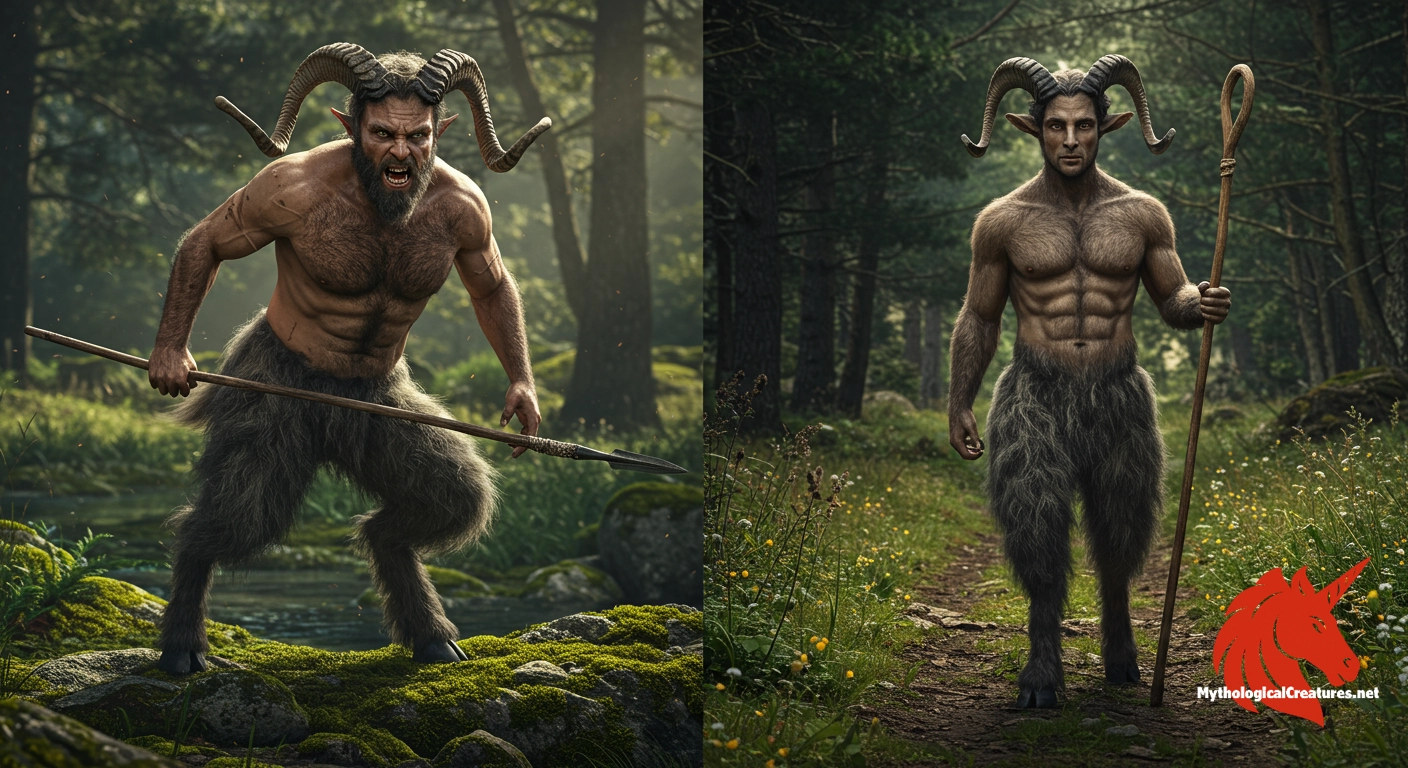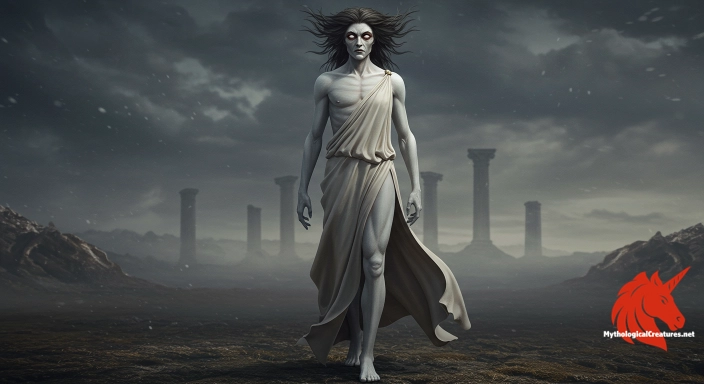Agreus and Nomios: Agreus and Nomios are mythological satyr-like beings spawned from the god Pan.

Agreus and Nomios
Agreus and Nomios - They embody the dual aspects of wildness and pastoral care in nature.
Origins & First Encounters
In the vibrant tapestry of Greek mythology, Agreus and Nomios stand out as enigmatic embodiments of nature’s dual forces. Their very names, meaning 'hunter' and 'shepherd', symbolise the enduring tension between the wild and the cultivated. Born from the realm of Pan, their origins are intertwined with the primal, ecstatic worship of nature. Their early attestation in myth underscores a tradition where lesser deities were celebrated for representing the harmony between untamed wilderness and pastoral order. The cultural context that birthed these figures was one that revered both the ferocity of the hunt and the tranquillity of pastoral life. Often conveyed through lyrical verses and fragmented tales of antiquity, their stories provided a mirror to the ancient Greek understanding of balance in the natural world. These divine personifications resonated with communities that depended equally on the unpredictability of nature and the steadiness of agriculture. Their mythological roles were not only symbolic but also functional in rites and seasonal festivals. The ongoing allure of Agreus and Nomios lies in their ability to evoke both the restless spirit of the wilderness and the gentle care required in shepherding the land.
Source Texts & Tale Variants
Ancient literary sources offer only brief and fragmented glimpses of Agreus and Nomios, with scattered references found in poetic fragments and scholia that highlight their connection to Pan. While comprehensive narratives about them are rare, later mythographers sometimes mention their presence among the myriad offspring of the god of the wild. Some classical texts, though not explicitly dedicated to these figures, embed their names within broader discussions of nature and divine multiplicity. Variations of their story appear in different regional folklore, where oral traditions have embellishments that are not captured in the surviving texts. The sparse nature of primary sources has led to multiple versions of their myth, with some sources emphasising the wild, restless character of Agreus and the gentle guardian aspect of Nomios. Despite the limited direct mentions in ancient literature, their roles have been pieced together through comparative studies of Pan’s iconography and the symbolic language of nature deities. This multiplicity of versions has allowed for flexible interpretations over time, ensuring that they remain intriguing to both scholars and enthusiasts. The enduring nature of these mythic fragments has kept the discussion of their roles alive in later literary and artistic works.
Form & Powers
Descriptions of Agreus and Nomios often draw from the archetypal imagery of Pan and his attendant satyrs, blending both human and bestial attributes. Agreus is typically envisioned with a rugged form that exudes the raw energy of the hunt, his features marked by wild, unkempt hair and a muscular build that hints at his untamable spirit. Nomios, on the other hand, is depicted with a more serene, pastoral countenance that reflects his association with shepherds and the gentle care of flocks. Both figures are frequently rendered with the lower bodies of goats, complete with cloven hooves and a thick, furry texture that symbolises their fusion with the natural world. Their faces often bear a dual expression of mischief and wisdom, reflecting the unpredictable blend of charm and wildness inherent to their nature. Artistic representations, whether in ancient vase paintings or later relief sculptures, emphasise their contrasting demeanours through subtle differences in posture and facial expression. Agreus might be seen brandishing hunting implements or juxtaposed against wild landscapes, while Nomios is more commonly shown with a shepherd’s crook, guiding his flock with an air of calm authority. Variations in size and proportion can be observed in different artistic traditions, yet the essential pastoral and untamed qualities remain consistent. Their physical depictions serve not only as a reflection of their mythic roles but also as enduring symbols of nature’s indomitable force and its gentle caretaking side.
Regional Faces
The representations of Agreus and Nomios have not remained static but have evolved with regional cultural nuances across the ancient Greek world. In central Greece, where the worship of Pan was deeply embedded in rural life, Agreus was often celebrated as a symbol of the wild, untamed landscapes that characterised the local countryside. Meanwhile, regions with strong pastoral traditions reinterpreted Nomios as a benevolent guardian of flocks and fields, a figure who brought both protection and fertility to the land. In Asia Minor and other parts of the Hellenic world, local cults adapted these figures to suit their own agrarian rituals, sometimes merging their distinctive qualities with indigenous nature spirits. Depictions in regional art reveal subtle differences, with Agreus sometimes appearing more formidable and frostier in arid or rugged locales, and Nomios exuding a softer, nurturing presence in areas renowned for their pastoral economy. Local festivals and rites would often highlight these variations, celebrating the divine interplay between raw nature and pastoral order. Such regional adaptations helped maintain the relevance of these deities in everyday rural life. The diversity in their portrayals across different geographies underscores how ancient communities tailored mythological imagery to reflect their own environmental and cultural contexts.
Cultural Parallels
When examined alongside similar mythological entities, Agreus and Nomios reveal intriguing parallels with other Indo-European nature deities. Their dual roles as embodiments of both wilderness and pastoral care draw close comparisons to the Roman fauns and satyrs, who similarly combined bestial traits with human-like disposition. In these comparative traditions, Agreus resonates with figures such as Herne the Hunter in British folklore, embodying a primal force that both terrifies and fascinates. Conversantly, Nomios shares thematic similarities with the gentle spirit of pastoral deities found in Roman mythology, like Faunus, whose presence assured fertility and protection over rural life. The amalgamation of human and animal traits seen in these figures underscores a common cultural motif where nature is personified to reflect its multifaceted character. Cross-cultural studies demonstrate that the symbolic dichotomy of wildness versus domestication is a recurring theme in many mythologies. These parallels testify to a broader human impulse to understand and represent the natural world through a blend of myth and allegory. In comparing these diverse traditions, one observes that the inherent dualism of Agreus and Nomios is a universal motif that continues to inspire artistic and literary reinterpretation across different cultures.
Legacy & Modern Evolution
Over the centuries, the legacy of Agreus and Nomios has evolved in tandem with changing artistic and cultural sensibilities. While explicit references to their names may have diminished, the traits they embody endured within the broader iconography of Pan and related nature spirits. During the Renaissance, artists reimagined these figures as allegories for the capricious yet fertile aspects of nature, weaving elements of both the wild hunt and pastoral serenity into their depictions. As European folklore shifted through the age of Romanticism, the pastoral and mystical qualities associated with these ancient beings resurfaced in literature, painting, and theatre. Their myth has since influenced modern fantasy genres, where the blend of human ingenuity and wild, untamed natural beauty is a frequent motif. Contemporary reinterpretations often see their attributes echoed in characters that symbolise the eternal tension between civilisation and the wilderness. Festivals, theatrical productions, and modern artworks continue to evoke the spirit of these mythic figures as symbols of nature’s paradoxical character. The evolution of their portrayal from classical antiquity to the modern day underscores a lasting fascination with the interplay between order and chaos in the natural world. Their enduring influence illustrates how ancient myth continues to shape modern cultural and artistic expressions, highlighting an unbroken dialogue between past and present.
Interesting Fact
A unique aspect of Agreus and Nomios is how their names literally encapsulate the dual facets of nature: the ferocity of the hunt and the care of the shepherd, mirroring the diverse roles of the god Pan himself.
Quick Creature Info
Origin:
Associations:
Our Mythic Legendary Rating:

Also Sometimes Known As:
Habitat:
Supernatural Powers:
Physical Attributes:
Abilities:
Behavior:
Lore:
References
Discover Another Mythical Legend You May Not Have Heard Of?
Uncover the mysteries of ancient folklore and expand your knowledge of legendary beings from cultures around the world.
Dare to Meet the Brimo....
Curated by the Mythological Creatures Team (rev. May 2025)
